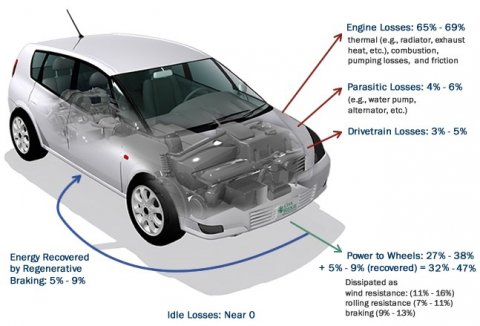SUBSCRIBE to the Fact of the Week
Hybrids are more efficient than comparable conventional vehicles, especially in stop-and-go driving, due to the use of regenerative braking, electric motor drive/assist, and start/stop technologies. Still, much of the energy is lost to engine and driveline inefficiencies or used to power accessories. About 25%–40% of the energy from the fuel you put in a hybrid is used to move it down the road, depending on the type of driving.
Energy Losses and Gains for a Hybrid Vehicle for Combined City and Highway Driving
Energy Losses and Gains for a Hybrid Vehicle for City, Highway, and Combined Driving
Note: The figure is primarily showing losses, but the regenerative braking gains are shown below 0%, offsetting some of the above losses.
Supporting Information
| Types of Driving | |||
|---|---|---|---|
| Combined | City | Highway | |
| Types of Losses | Energy Losses | ||
| Engine Losses | 65-69% | 66-72% | 63-66% |
| Parasitic Losses, e.g. water pump, alternator, etc. | 4-6% | 5-7% | 2-4% |
| Power to Wheels, dissipated as: | 27-38% | 25-40% | 29-36% |
| Wind Resistance | 11-16% | 6-11% | 17-23% |
| Rolling Resistance | 7-11% | 6-11% | 8-11% |
| Braking | 9-13% | 13-20% | 3-4% |
| Drivetrain Losses | 3-5% | 3-5% | 3-5% |
| Idle Losses | 0% | 0% | 0% |
| Types of Gains | Energy Gains | ||
| Regenerative Braking | 5-9% | 8-14% | 2-4% |
Source: U.S. Department of Energy and U.S. Environmental Protection Agency, Fuel Economy Guide website. | |||



